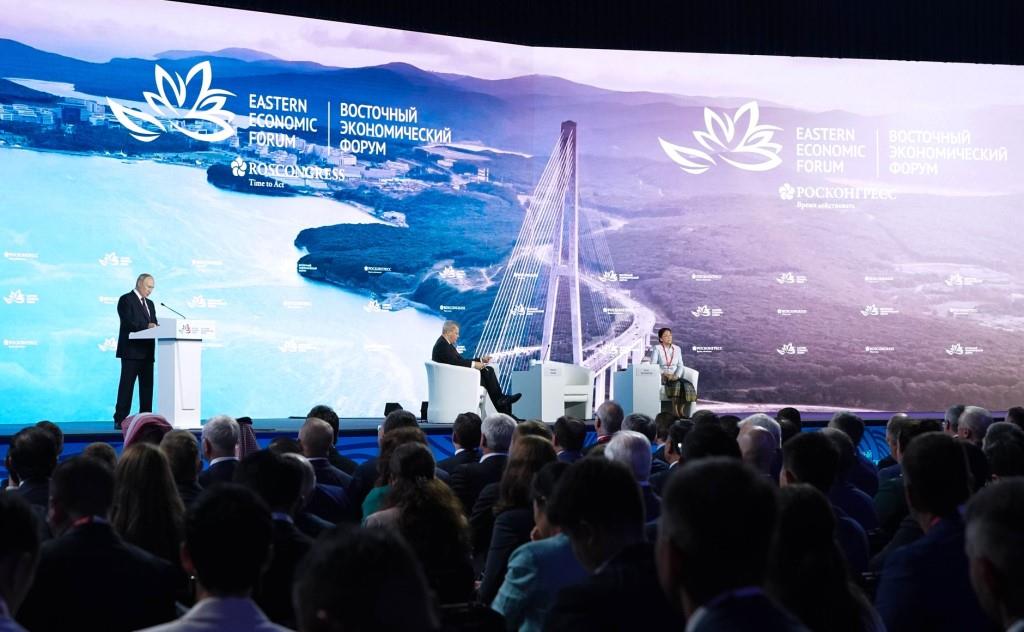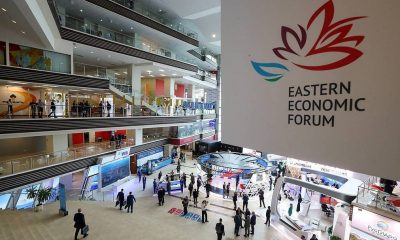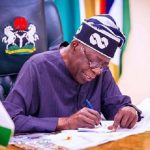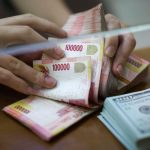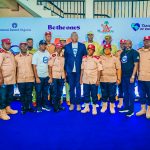World
Russia’s Far East Witnessing Series of Record-Breaking Agreements
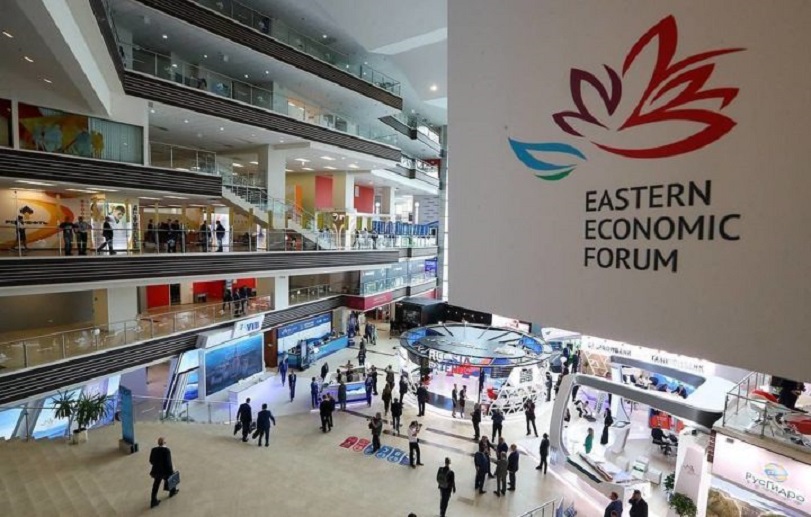
By Kestér Kenn Klomegâh
Vladivostok, located in Russia’s Far East, hosted the 8th Eastern Economic Forum (EEF) from 12th to 13th September 2023 in an attempt to define further the development of this remote region. Since the beginning of the EEF in 2015, it has, until COVID-19 was followed by Russia’s own ‘special military operation’ in neighbouring Ukraine, the focus was largely on harnessing resources from the United States and Europe to the Far East region of the Russian Federation.
Speeches and all kinds of remarks highly praised Western, European and Asia-Pacific participating countries and corporate enterprises under resonating themes such as ‘A Common Economic Space from the Atlantic to the Pacific: The Greater Eurasian Partnership’, which was framed to develop trade and economic cooperation from Lisbon to Vladivostok. Research shows that the EEF held previously, especially the first three in 2015 to 2018, strategically aimed at broadening international cooperation and promoting the Far East as the gateway to the Asian-Pacific region.
Despite the series of sanctions, corporate European businesses are still highly interested in Russia, and Russia recognizes these businesses’ enormous significance and invaluable contributions to its economy. Foreign Minister Sergey Lavrov, during those hay years, had always been the guest speaker during the Association of European Business (AEB), an organization which unites European companies in the Russian Federation.
“We value opportunities for dialogue with European entrepreneurs aimed at pushing forward a pragmatic, politics-free and mutually beneficial agenda designed to improve the wellbeing of the people in Russia,” Lavrov said and rained a lot of praises when the AEB marked its 25th year early October 2020. The interest in strengthening and diversifying trade and economic ties had grown since the Soviet collapse. According to statistics, the European Union’s investment in Russia reached almost US$300 billion back in 2019.
Russia is ready to build its relations with the European Union along some principles. The European Union remains its important trade partner. As before, there is optimism that both are open to cooperation; European partners are keen on building businesses in the economic space from Lisbon to Vladivostok, this vast country and in the Eurasian region.
Obviously, the future Russia and European business relations could still be consolidated despite the current political differences. After all, Russia and the EU countries not only belong to the same cultural and civilizational matrix but are also linked by many ties in trade and investment cooperation, scientific and technological exchange and personal contacts. Russians spend their vacation in Europe. There are visible signs that Europeans are interested in Far East development projects and participating in diverse spheres in cooperating with the economy there.
Even long before COVID-19, Russia continued working on attracting investment to the Far East from external countries and enterprises. Outcomes of the 2019 forum (that was the 5th forum) released by the forum organizers, for instance, showed that among the 65 countries represented were Australia, Austria, Belgium, Canada, Czech Republic, Denmark, Estonia, Finland, France, Germany, Great Britain, Italy, Japan, Luxembourg, the Netherlands, New Zealand, Slovakia, Spain, Switzerland, Sweden and the United States.
The 2019 forum business dialogues included ‘Russia-Europe’ among the six for that year. One of the expert business lectures was the United Kingdom on economics and international relations. The session was moderated by Sergei Brilev, Russia TV Channel Anchor and Deputy Director and President of the Bering Bellingshausen Institute for the Americas. And there at the session, Vladimir Putin acknowledged hosting over 8,500 participants from 65 countries. Since the first forum, representation had increased more than twofold, a convincing indication of growing colossal interest in opportunities offered by the Russian Far East.
Prime Minister of Japan Shinzō Abe: “I want you to spread the wings of imagination and see the new opportunities Japan can bring into your future. Let us create history together; let us pave the way.”
Prime Minister of Malaysia Mahathir Bin Mohamad: “It was great to hear that of all regions, Russia is going to develop the Far East. Russia is one of the few countries that is located both in Europe and Asia. Its unique geographical location makes it a bridge between East and West, between Europe and Asia. I suppose this unique situation will help Russia play an important role in both Europe and the Far East.”
“We are still going to aim high. At the same time, if, before the first EEF five years ago, you had asked me to guess the future – I don’t think I would have said 1800 projects. Perhaps I would have been ambitious enough to guess 300, and I would have thought that daring. 1800 projects launched in the Far East – it is simply amazing. I am confident the preferential economic policy, initiated at the behest of the President of the Russian Federation, works,” said Yuri Trutnev, Deputy Prime Minister of the Russian Federation, Presidential Plenipotentiary Envoy to the Far Eastern Federal District.
“The 5th anniversary Eastern Economic Forum was record-breaking in terms of participation numbers and the total worth of contracts signed during the event. These accomplishments prove that the Forum became a significant platform to promote international cooperation and discuss relevant global and regional economic issues,” said Anton Kobyakov, Advisor to the President of the Russian Federation and Executive Secretary of the Eastern Economic Forum Organizing Committee.
Over the past few years, there have been brief analytical summaries showing increasing trade relations between Russia and China. In particular, and from a geopolitical point of view, China is moving towards attaining its global status within the evolutionary processes of multipolarity. China is building on its potential facilities to penetrate through the Far East to Central Asia and former Soviet republics.
However, with the complexities and contradictions of the geopolitical situation, Russia has abandoned its initial post-Soviet Western and European dreams. The United States, Europe and the Baltics were all deleted from Russia’s radar. Russia is partitioning rather than pursuing an integrative multipolar world. At least, these are very visible within the framework of its foreign policy.
Outcomes of the 4th EEF (September 2018) held under the theme ‘The Far East: Expanding the Range of Possibilities’ were significantly not different. It featured the President of the People’s Republic of China, Xi Jinping; the President of Mongolia, Khaltmaagiin Battulga; the Prime Minister of Japan, Shinzō Abe; and the Prime Minister of the Republic of Korea, Lee Nak-yon.
President of the People’s Republic of China Xi Jinping emphasized: “The Eastern Economic Forum, established by the initiative of President Putin, has already been successfully held three times and has become an important platform for consolidating brainpower and discussing key cooperation-related matters. This year, the Forum is attended by an unprecedented number of guests and friends from different countries.”
President of Mongolia Khaltmaagiin Battulga said: “The Annual Eastern Economic Forum is becoming an important discussion platform for outlining further ways of cooperation for the APR countries. Each year, the level of participants is rising, and the Forum is expanding.”
Prime Minister of Japan Shinzō Abe: “Russian–Japanese relations are now going through a breakthrough period with unprecedented acceleration. The plan of bilateral cooperation that we discussed with President Putin includes over 150 projects. Over a half of them are already being implemented or are approaching this stage.”
Prime Minister of the Republic of Korea Lee Nak-yeon said: “Leaders of the Northeast Asian states have gathered at this platform to consolidate efforts and ideas for the development of the Far East and ensure peace and well-being for the region. This is crucial.”
Over 340 heads of foreign businesses took part in the forum. There were 6,002 delegates, and 220 agreements worth 3.108 billion roubles were signed (only agreements, the value of which does not constitute a commercial secret). The most significant agreements were:
- Baimskaya Mining Company, KAZ Minerals PLC, the Government of Chukotka Autonomous Area and the Ministry of Economic Development of Russia signed an agreement in the amount of 360 billion roubles on the implementation of the investment project to develop the Baimskaya ore zone (Chukotka Autonomous Area);
- United Aircraft Corporation (UAC) and Aeroflot signed an agreement in the amount of 210 billion roubles on the consignment of Sukhoi Superjet 100 aircraft;
- Nakhodka Fertilizer Plant and Far East Development Corporation signed an agreement to create a clean methanol and ammonia production facility;
- NOVATEK, Government of Kamchatka Territory and Ministry for the Development of the Russian Far East signed an agreement in the amount of 69.5 billion roubles on the construction of a terminal for transhipment and storage of liquefied natural gas;
- Russian Direct Investment Fund (RDIF), Japanese conglomerate Marubeni Corporation and AEON Corporation signed an agreement on the terms for financing the construction of a chemical cluster in Volgograd;
- The Russian Direct Investment Fund, Alibaba Group, MegaFon and Mail.Ru Group announced a new strategic partnership to integrate Russia’s key consumer internet and e-commerce platforms and launch a leading social commerce joint venture in Russia and the CIS;
- Leonid Petukhov, CEO of the Far East Investment and Export Agency, and Yoichi Nishikawa, CEO of Iida Group, signed an agreement in the amount of 14.960 billion roubles on cooperation in the implementation of the project for the construction of a wood processing complex for the production of sawn timber for wooden model houses, as well as the construction and sale of wooden low-rise houses;
- Aysen Nikolayev, Acting Head of the Republic of Sakha (Yakutia), and Yuri Korotaev, CEO of Duracell Russia, signed the agreement in the amount of 15 billion roubles on interaction in the area of social and economic development of the Republic of Sakha (Yakutia);
- Dmitry Kobylkin, Minister of Natural Resources and Environment of Russia, and Yuri Korotaev, CEO of Duracell Russia, signed an agreement on mutually beneficial cooperation in the establishment of a new class 2 waste management system;
- Rosneft and Beijing Gas Group Co. Ltd. signed an agreement to secure the essential conditions for the establishment of a joint venture for the construction and operation of a network of gas filling compressor stations (CNGS) in Russia;
- Gazprom and Mitsui & Co. Ltd. signed a memorandum of understanding on the Baltic LNG project in order to consider the opportunities for cooperation in the project;
- Far East Development Corporation and Rostelecom PJSC signed an agreement on connecting the 18 advanced special economic zones in the Far East to fibre-optic communication lines;
- Novatek and Rosatomflot signed an agreement on the intention to jointly develop and build an icebreaker fleet operating on LNG.
The 6th Eastern Economic Forum (2021) still has restrictions in place due to the risk posed by the coronavirus. This, of course, affected the number of participants at the event. Nevertheless, more than 4,000 participants, including more than 400 heads of companies. Westerners and Europeans disappeared from the forum. Online guest speakers included the President of the Republic of Kazakhstan, Kassym-Jomart Tokayev and the President of Mongolia, Ukhnaagiin Khürelsükh. There were also video greetings by President of China Xi Jinping, Prime Minister of the Republic of India Narendra Modi, and Prime Minister of the Kingdom of Thailand Prayuth Chan-o-cha.
In addition to the usual discussion on the Far East, there was a discussion on the Greater Eurasian Partnership. A range of topics came under the spotlight, including the values of young people from the Far East, obstacles encountered by young entrepreneurs, the education system, the impact of social media, the future of the financial market, copyright, raising investment, getting young people involved in developing the urban environment, career guidance, cooperation with young people in other countries, and the adaptation of the tourist industry.
But a record 380 agreements were signed worth a total of RUB 3.6 trillion (excluding agreements where the figures were classified as commercial secrets), according to the official documents. Twenty-four were signed with foreign and international companies, ministries, and government bodies, including nine with China, six with Japan, three with Kazakhstan, and one with Austria, Vietnam, Canada, Serbia, South Korea, and Ethiopia.
Quite recently, the 7th Eastern Economic Forum concluded in September 2022. With the major challenges that Russia is facing from sanctions, the macro-regions importance is growing rapidly. Russian President Vladimir Putin noted an enormous contribution to building business ties between Russia and the countries of the Asia-Pacific region. He remarked, “there is already a trend of the Asia-Pacific region becoming a centre of world economic activity, along with the gradual extinction of industrial centres in Europe and the United States.”
According to the forum documents, it was the first post-COVID forum and was attended by more than 7,000 guests. Despite the sanctions and external pressure, 2,729 investment projects are being implemented in the Far East. More than 290 agreements were signed for a total of RUB 3.27 trillion, including agreements on infrastructure and transport projects, the development of large mineral deposits, as well as construction, industry, and agriculture. More than 7,000 participants from 68 countries and Russia’s territories, including 1,700 business representatives from 700 companies. Western and Europeans disappeared at the 2022 forum. Asian countries have become new centres of economic and technological growth and points of attraction for human resources, capital and industries.
Adviser to the Russian President and Executive Secretary of the EEF 2022 Organizing Committee, Anton Kobyakov, remarked that “Vladivostok could become Russia’s international tourist gateway to the Asia-Pacific region. Let foreign tourists come and bring their relatives and friends.” But the new opportunities mean work needs to be intensified with only friendly countries.
For the year 2023, the Southeast Asian business community, in particular, expressed an active interest in Russian projects and a readiness not only to talk but also to take concrete action, according to the Business & Financial newspaper Izvesti.
“The main issue is agreements on cooperation, technological interaction and the creation of joint ventures. And one thing is certain: The Far East becomes the primary location for potential developments and availability of multiple opportunities,” Georgy Ostapkovich, Director of the Center for Market Studies at the Higher School of Economics (HSE University), noted. He emphasized that it is currently difficult to quantify the number and value of contracts signed at the event. Analysts had predicted that the number of contracts inked at EEF-2023 would be the same as last year, which came in at around 3.2 trillion rubles ($33.08 billion).
Russian President Vladimir Putin said at the opening session that the government would not allow the pace of development to slacken in the Russian Far East as it is a strategic region for the country. “We will definitely not be scaling down the pace of development in the region because the development of the Far East is an absolute priority for Russia, a direct priority for Russia as a whole for the entire 21st century, because it is a colossal region with a small population but huge potential. Of course, this is a strategic interest for the country,” the president said at the Eastern Economic Forum, which Vladivostok hosted on September 10-13.
The Eastern Economic Forum (EEF) is held annually in cooperation with the Far East regional administration in the city of Vladivostok. Three years of COVID-19, followed by Russia’s ‘special military operation’ and the current geopolitical situation, have adversely affected this corporate business event, as Russia looks towards the East and makes the main focus on developing the Far East. One of the crucial steps, which is missing, are to see the essential results since its launch in 2015.
For the past few years, Western and European businesses have largely been missing in this forum. And those from Asia and the Pacific are getting fewer and fewer as opportunities seem monotonous and speeches have the same message relating to world geopolitics. Analysts, expressing much concern, say business people are really looking for corporate business opportunities, not hard geopolitics. From the perspective of investors, the region is of serious interest, but there is an imbalance between practical investment and economic potential in the region.
Many of the speakers were very frank and objective in their speeches and highlighted possible ways for modernizing the region. It is important to highlight concrete success stories. In other words, reshaping and scaling up efforts are necessary, leading to cutting the white ribbons marking the completion of projects. The Eastern Economic Forum was established by decree of President of the Russian Federation Vladimir Putin in 2015 to support the economic development of Russia’s Far East and to expand international cooperation in the Asia-Pacific region.
Given the vast territory of the Far East, 6.3 million people translate to slightly less than one person per square kilometre, making the Far East one of the most sparsely populated areas in the world. Until 2000, the Russian Far East lacked officially-defined boundaries. A single term, “Siberia and the Far East”, often referred to Russia’s regions east of the Urals without drawing a clear distinction between “Siberia” and “the Far East”. However, the Far East is generally considered the easternmost territory of Russia, between Lake Baikal in Eastern Siberia and the Pacific Ocean.
World
Comviva Wins at IBSi Global FinTech Innovation Award
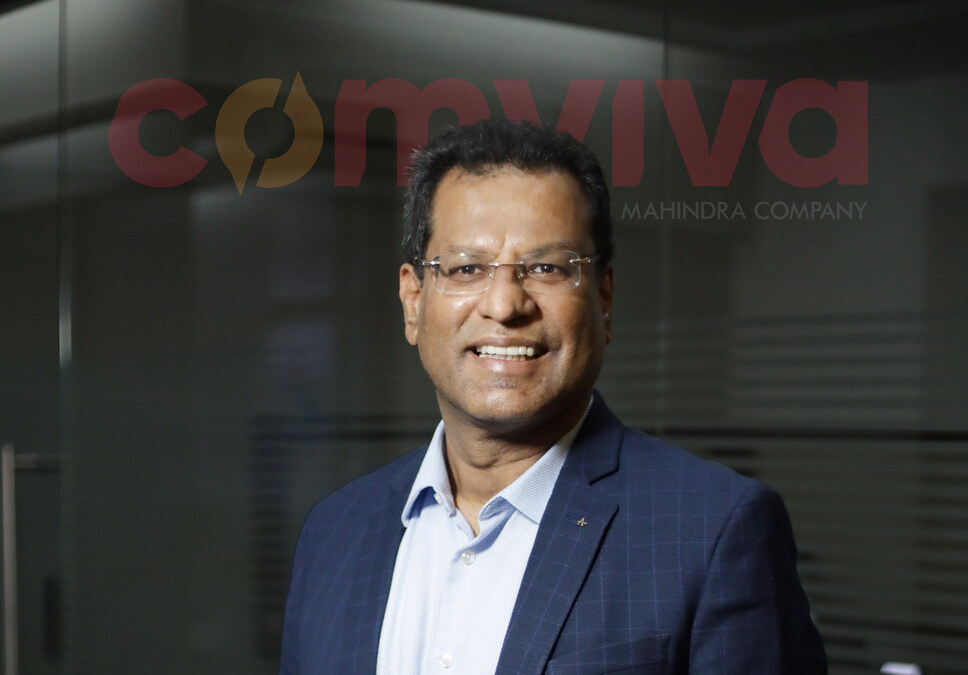
By Modupe Gbadeyanka
For transforming cross-border payments through its deployment with Global Money Exchange, Comviva has been named Best In-Class Cross Border Payments.
The global leader in digital transformation solutions clinched this latest accolade at the IBS Intelligence Global FinTech Innovation Award 2025.
The recognition highlights how Comviva’s mobiquity Pay is helping shape a modern cross-border payment ecosystem that stretches far beyond conventional remittance services.
Deployed as a white label Wallet Platform and launched as Global Pay Oman App, it fulfils GMEC’s dual vision—positioning itself as an innovative payment service provider while digitally extending its core money transfer business.
The solution allows GMEC to offer international money transfers alongside seamless forex ordering and other services. These capabilities sit alongside a broad suite of everyday financial services, including bill and utility payments, merchant transactions, education-related payments, and other digital conveniences — all delivered through one unified experience.
“This award is a testament to Oman’s accelerating digital transformation and our commitment to reshaping how cross-border payments serve people and businesses across the Sultanate.
“By partnering with Comviva and bringing the Global Pay Oman Super App, we have moved beyond traditional remittance services to create a truly inclusive and future-ready financial ecosystem.
“This innovation is not only enhancing convenience and transparency for our customers but is also supporting Oman’s broader vision of building a digitally empowered economy,” the Managing Director at Global Money Exchange, Subromoniyan K.S, said.
Also commenting, the chief executive of Comviva, Mr Rajesh Chandiramani, said, “Cross-border payments are becoming a daily necessity, not a niche service, particularly for migrant and trade-linked economies.
“This recognition from IBS Intelligence validates our focus on building payment platforms that combine global reach with local relevance, operational resilience and a strong user experience. The deployment with Global Money Exchange Co. demonstrates how mobiquity® Pay enables financial institutions to move beyond remittances and deliver integrated digital services at scale.”
“The deployment of mobiquity Pay for GMEC showcases how scalable, API-driven digital wallet platforms can transform cross-border payments into seamless, value-rich experiences.
“By integrating remittances, bill payments, forex services, and AI-powered engagement into a unified Super App, Comviva has reimagined customer journeys and operational agility.
“This Best-in-Class Cross-border Payments award win stands as a testament to Comviva’s excellence in enabling financial institutions to compete and grow in a digitally convergent world,” the Director for Research and Digital Properties at IBS Intelligence, Nikhil Gokhale, said.
World
Russia Renews Africa’s Strategic Action Plan
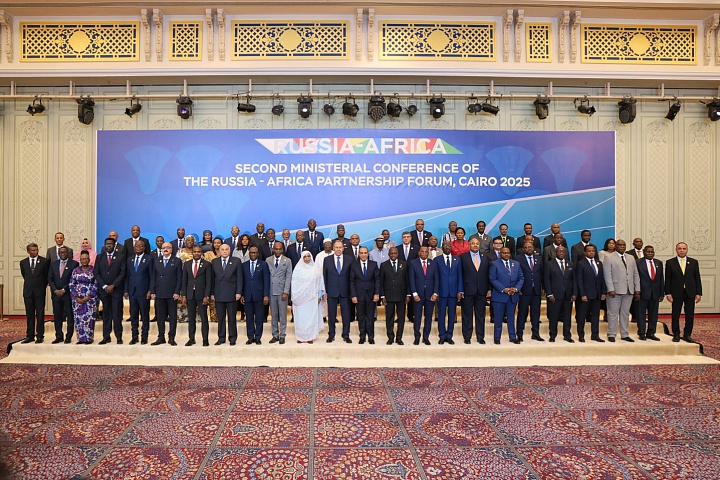
By Kestér Kenn Klomegâh
At the end of an extensive consultation with African foreign ministers, Russian Foreign Minister, Sergey Lavrov, has emphasized that Moscow would advance its economic engagement across Africa, admittedly outlining obstacles delaying the prompt implementation of several initiatives set forth in Strategic Action Plan (2023-2026) approved in St. Petersburg during the Russia-Africa Summit.
The second Ministerial Conference, by the Russian Foreign Ministry with support from Roscongress Foundation and the Arab Republic of Egypt, marked an important milestone towards raising bilateral investment and economic cooperation.
In Cairo, the capital city of the Arab Republic of Egypt, Lavrov read out the final resolution script, in a full-packed conference hall, and voiced strong confidence that Moscow would achieve its strategic economic goals with Africa, with support from the African Union (AU) and other Regional Economic blocs in the subsequent years. Despite the complexities posed by the Russia-Ukraine crisis, combined with geopolitical conditions inside the African continent, Moscow however reiterated its position to take serious steps in finding pragmatic prospects for mutual cooperation and improve multifaceted relations with Africa, distinctively in the different sectors: in trade, economic and investment spheres, education and culture, humanitarian and other promising areas.
The main event was the plenary session co-chaired by Russian Foreign Minister Sergey Lavrov and Egyptian Minister of Foreign Affairs, Emigration, and Egyptians Abroad Bashar Abdelathi. Welcome messages from Russian President Vladimir Putin and Egyptian President Abdelhak Sisi were read.
And broadly, the meeting participants compared notes on the most pressing issues on the international and Russian-African agendas, with a focus on the full implementation of the Russia-Africa Partnership Forum Action Plan for 2023-2026, approved at the second Russia-Africa Summit in St. Petersburg in 2023.
In addition, on the sidelines of the conference, Lavrov held talks with his African counterparts, and a number of bilateral documents were signed. A thematic event was held with the participation of Russian and African relevant agencies and organizations, aimed at unlocking the potential of trilateral Russia-Egypt-Africa cooperation in trade, economic, and educational spheres.
With changing times, Africa is rapidly becoming one of the key centers of a multipolar world order. It is experiencing a second awakening. Following their long-ago political independence, African countries are increasingly insisting on respect for their sovereignty and their right to independently manage their resources and destiny. Based on these conditions, it was concluded that Moscow begins an effective and comprehensive work on preparing a new three-year Cooperation and Joint Action Plan between Russia and Africa.
Moreover, these important areas of joint practical work are already detailed in the Joint Statement, which was unanimously approved and will serve as an important guideline for future work. According to reports, the Joint Statement reflects the progress of discussions on international and regional issues, as well as matters of global significance.
Following the conference, the Joint Statement adopted reflects shared approaches to addressing challenges and a mutual commitment to strengthening multifaceted cooperation with a view to ensuring high-quality preparation for the third Russia-Africa Summit in 2026.
On December 19-20, the Second Ministerial Conference of the Russia-Africa Partnership Forum was held in Cairo, Egypt. It was held for the first time on the African continent, attended by heads and representatives of the foreign policy ministries of 52 African states and the executive bodies of eight regional integration associations.
World
TikTok Signs Deal to Avoid US Ban

By Adedapo Adesanya
Social media platform, TikTok’s Chinese owner ByteDance has signed binding agreements with United States and global investors to operate its business in America.
Half of the joint venture will be owned by a group of investors, including Oracle, Silver Lake and the Emirati investment firm MGX, according to a memo sent by chief executive, Mr Shou Zi Chew.
The deal, which is set to close on January 22, 2026 would end years of efforts by the US government to force ByteDance to sell its US operations over national security concerns.
It is in line with a deal unveiled in September, when US President Donald Trump delayed the enforcement of a law that would ban the app unless it was sold.
In the memo, TikTok said the deal will enable “over 170 million Americans to continue discovering a world of endless possibilities as part of a vital global community”.
Under the agreement, ByteDance will retain 19.9 per cent of the business, while Oracle, Silver Lake and Abu Dhabi-based MGX will hold 15 per cent each.
Another 30.1 per cent will be held by affiliates of existing ByteDance investors, according to the memo.
The White House previously said that Oracle, which was co-founded by President Trump’s supporter Larry Ellison, will license TikTok’s recommendation algorithm as part of the deal.
The deal comes after a series of delays.
Business Post reported in April 2024 that the administration of President Joe Biden passed a law to ban the app over national security concerns, unless it was sold.
The law was set to go into effect on January 20, 2025 but was pushed back multiple times by President Trump, while his administration worked out a deal to transfer ownership.
President Trump said in September that he had spoken on the phone to China’s President Xi Jinping, who he said had given the deal the go ahead.
The platform’s future remained unclear after the leaders met face to face in October.
The app’s fate was clouded by ongoing tensions between the two nations on trade and other matters.
-

 Feature/OPED6 years ago
Feature/OPED6 years agoDavos was Different this year
-
Travel/Tourism9 years ago
Lagos Seals Western Lodge Hotel In Ikorodu
-

 Showbiz3 years ago
Showbiz3 years agoEstranged Lover Releases Videos of Empress Njamah Bathing
-

 Banking8 years ago
Banking8 years agoSort Codes of GTBank Branches in Nigeria
-

 Economy3 years ago
Economy3 years agoSubsidy Removal: CNG at N130 Per Litre Cheaper Than Petrol—IPMAN
-

 Banking3 years ago
Banking3 years agoFirst Bank Announces Planned Downtime
-

 Banking3 years ago
Banking3 years agoSort Codes of UBA Branches in Nigeria
-

 Sports3 years ago
Sports3 years agoHighest Paid Nigerian Footballer – How Much Do Nigerian Footballers Earn



